Eight shrub frog species named after Sri Lankans
by Dhaneshi Yatawara
In 1957 only 35 species of Amphibians were discovered from Sri Lanka.
This number increased to 53 by 1996, according to the 2012 National Red
List of Sri Lanka. In 2004 Global Amphibian Assessment showed that 34
species of Amphibians have gone extinct from the world within the past
500 years and out of this 21 are from Sri Lanka, as of 2012. Among these
Sri Lankan species 19 belong to 'Pseudophilautus' the shrub frog. With
the rediscovery of Kandyan Dwarf Frog ('Adenomus kandianus') in 2012 and
shrub frog 'Pseudophilautus stellatus' in 2013 by leading herpetologist
Mendis Wickramasinghe and his team, the number of amphibians believed to
be extinct came down to 19. Today the team lead by Wickramasinghe has
discovered eight new species of shrub frogs 'Pseudophilautus'.
These new members symbolise and remind over and over again the
mysteries Sri Lanka's high biodiversity may hold. Those once discovered
will surprise the biodiversity enthusiastic world. The new eight species
of shrub frogs are named honouring the service of eight prominent Sri
Lankans who are historical heroes, conservationists and scientists who
have been standing strong in protecting the country and the environment.
These eight new species of Pseudophilautus are namely - 'Pseudophilautus
bambaradeniyai', 'P. dayawansai', 'P. jagathgunawardanai', 'P.
karunarathnai', 'P. newtonjayawardanei', 'P. puranappu', 'P.
samarakoon', and 'P. sirilwijesundarai'.
L.J. Mendis Wickramasinghe, is the founder and President of the
Herpetological Foundation of Sri Lanka, and is the Principal
Investigator in this current project. He has close to two decades of
field herpetological experience in Sri Lanka with a focus on taxonomic
identifications, and also providing education and awareness to the
general public on venomous snakes in the island. He has contributed his
expertise towards national projects on identification of threatened
species in Sri Lanka A member of the Experts Committee on herpetofauna
in Sri Lanka, under the National Species Conservation Advisory Group and
in several international bodies including several Species Survival
Commission groups of the International Union for Conservation of Nature.
Other members of the team are Dulan Ranga Vidanapathirana, M.D. Gehan
Rajeev, S. Chathuranga Ariyarathne, A.W. Amila Chanaka, L.L. Dharshana
Priyantha, Imesh Nuwan Bandara and Nethu Wickramasinghe.
Samples of these new species are deposited in Natural Museum of Sri
Lanka, the Department of Wildlife Conservation and National Wildlife
Research and Training Centre, Girithale. The new species were compared
with all types from Sri Lanka, deposited in the natural Museum and
specimens deposited in the Natural History Museum in London.
As the team has discovered the conservation status of all species
described here, except for Newton Jayawardane's shrub frog, have been
considered Critically Endangered considering the ground situation of the
animal according to the IUCN Red List criteria. This is because all
these species were seen in areas less than 100 square kilometres and are
recorded from single locations, and their habitats are under severe
threat. The Newton Jayawardane's shrub frog will have to be treated as
Data Deficient as it is described based on a single specimen, according
to the research team.
In Sri Lanka Amphibians are not killed or collected for economical
purposes – not yet recorded. Yet these animals hold a prestigious place
in the animal world. Discovery of new eight species shows the importance
of more and more research in finding more details about our rich
environment – especially those that need to be conducted by local
researchers.
Though many new species are discovered in this Peak Wilderness it is
facing a greater threat from human activities. The highest peak,
Sripada, is worshipped by all ethnicities of the country. Peak
Wilderness sanctuary is a tropical rain forest that spreads over a land
of 224 square kilometers around the Sripada (Adam's Peak) mountain.
Millions visit this site every year during the pilgrim season which
lasts for a period of six months. Thus garbage gets collected and the
natural forest gets over-exploited. The research team during their
survey has observed illegal gem mining happening on either sides of the
river bank within the forest is another potential threat to the
amphibian diversity as well as tea cultivation in the surrounding areas
which is slowly expanding. Illegal tree felling to cultivate tea has
become a major threat in the area.
Peak Wilderness was recently declared as Central Hills World Heritage
Site by UNESCO. It is one of the few remaining virgin forests with a
continuous natural forest cover and forests that change its
characteristics with relevance to altitude and influenced by different
climatic zones, researchers describe. As the team continue to highlight
amongst the most important findings in this region is the forest die
back possibly due to pollution and/or climate change. Accordingly it has
never been documented in this region before and a large area has now
been affected with the natural forest cover slowly declining.
“At the current rate of destruction of the natural habitats in the
region the amphibians are at a higher risk of extinction, where they may
be extirpated without ever being known to science. The novel
descriptions presented here hopefully will set a basis for future
conservation efforts in the region,” the research team states.
Bambaradeniya’s Shrub Frog
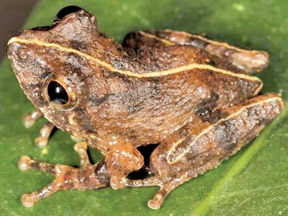
'Pseudophilautus bambaradeniyai' (Bambaradeniyage panduru madiya or
in English Bambaradeniya’s Shrub Frog) is named after Channa
Bambaradeniya, a leading wetland scientist who has been working
immensely to protect the wetlands and its ecosystems in Sri Lanka. This
is a small frog found in elevations of 750–1400 m from the forest floor
to about 1.5m high shrubs in lowland rain forests to lower montane rain
forests.
Dayawansa’s Shrub Frog
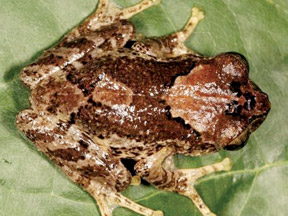
Dayawansa’s Shrub Frog or Dayawansage panduru madiya in Sinhala (P.
dayawansai) is named after Nihal Dayawansa, Senior Lecturer of the
Department of Zoology, University of Colombo in recognition of his
dedicated service and commitment towards amphibian research work in Sri
Lanka. The species name dayawansai is a noun in the genitive case.
Dayawansa’s Shrub Frog is a small sized frog found in cloud forests of
elevation 1550–1900 m above sea level from forest floor to about 2m high
shrubs.
Jagath Gunawardana’s Shrub Frog

Jagath Gunawardana’s Shrub Frog ('P. jagathgunawardanai ') is named
by the team after Jagath Gunawardana, a leading attorney at law and
naturalist, in appreciation of his services towards the conservation of
Sri Lanka’s biodiversity and for his efforts on environmental policy
making in the island. The species is found mainly in cloud forests of
elevation 1600–1750 m from forest floor to about 6m high trees. They are
commonly observed on tree trunks with lichens, or were hidden in cracks
on barks or on shrubs.
Karunarathna's Shrub Frog

P. karunarathnai is named after retired Assistant Director,
Department of Wildlife Conservation Y.G.P. Karunarathna, in appreciation
of his commendable services to wildlife management which has resulted in
the minimizing of the human-wildlife conflict on the island. The species
is found in elevations of 750–1400 m, from the forest floor to about
1.5m high shrubs in lowland rain forests and lower montane rain forests.
Apart from forests they are also observed in home gardens without much
canopy cover.
Newton Jayawardane’s Shrub Frog
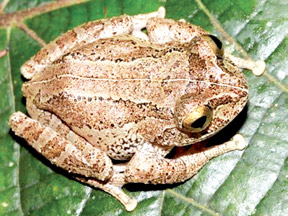
P. newtonjayawardanei or Newton Jayawardane’s Shrub Frog is named
after Newton Jayawardane, a leading surgeon by profession and is an
ardent naturalist, in great appreciation of his dedicated service to the
country, both as a surgeon and a wildlife conservationist. This neither
large nor small frog was observed in the forest canopy at very high
altitudes with elevations ranging from 1800–2000 metres and was very
rare, according to the research team. Only two specimens have been
observed so far, from about 8m high trees. They perch on leaves and are
very hard to sight.
Puran Appu's Shrub Frog
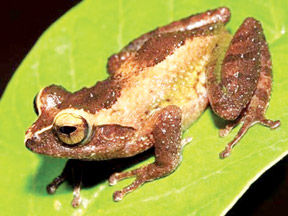
Honouring a hero of motherland Veera Puran Appu, P. puranappu (Puran
Appu's shrub frog) is named. Veera Puran Appu whose real name was
Veerahennadige Francisco Fernando who was executed by the British in
1848 was a leader who stood against the might of the British Empire.
According to the research team, the species was observed even during day
time. It was commonly seen perched on rocks in shady places during the
day. As they further explained these frogs nocturnally could be observed
perched on bushes with about one metre height. Mostly seen in places
where there was no canopy cover, in disturbed areas even on the Peak
top. The species was commonly recorded from the highest elevations of
2000–2100 metres but low populations were also observed from about
1800m.
Samarakoon's Shrub Frog
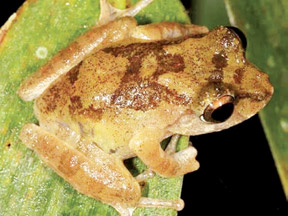
The other species 'P. samarakoon' is named after Ananda Vijith
Samarakoon who is an Assistant Director in the Department of Wildlife
Conservation greatly involved in educating and training wildlife
officers which in turn have contributed to safeguarding the Sri Lankan
biodiversity. The species was found in elevations of 1000–1400 m from
the forest floor to about 2metres high shrubs and in bamboo of the lower
montane rain forests. They were commonly found perched on bamboo plants
close to the stream.
Siril Wijesundara's Shrub Frog
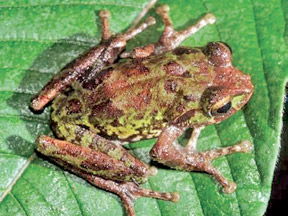
P. sirilwijesundarai is named after one of Sri Lanka's leading
botanists Dr. Siril Wijesundara. At present Dr. Wijesundara is the
Director General of the Department of Botanic Gardens under which the
Peradeniya Royal Botanic Gardens is operated. As the researchers
explained the species was found at high altitudes of elevations ranging
from 1600–1700 metres in the montane cloud forests. They were found in
the canopy on trees along side mosses, from about 10metre tall tree
branches.
Pix Courtesy: L.J. Mendis Wickramasinghe |



